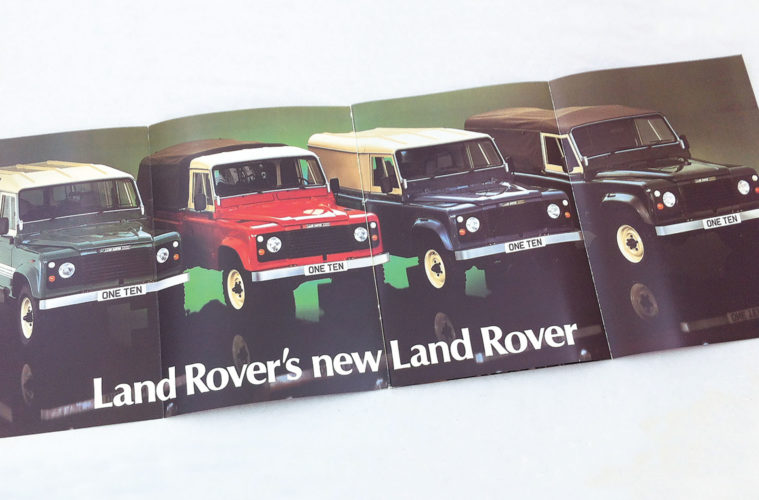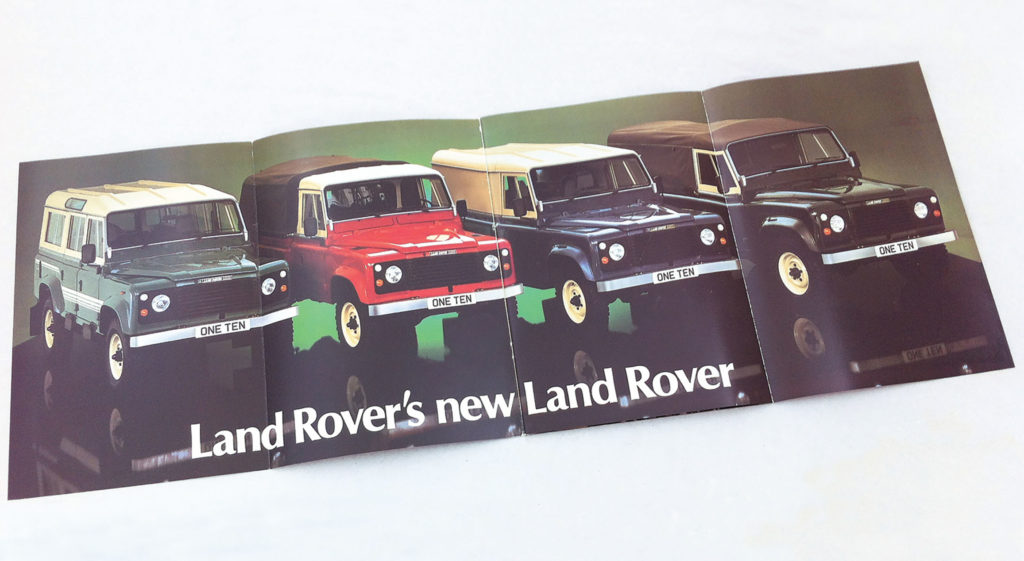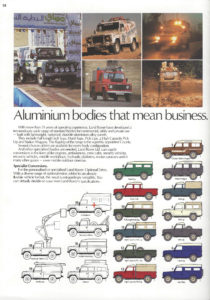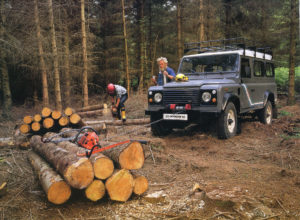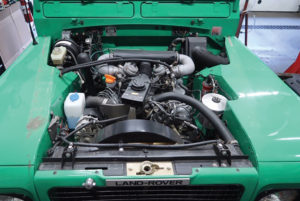The iconic Land Rover we now generically label as Defender first appeared in 1983, in long wheelbase form, marketed as the Land Rover One Ten. The Land Rover Ninety and One Two Seven arrived the following year. These models replaced the leaf-spring, drum brake Series III 88” and 109”. Aside from a slightly different look, The One Ten and Ninety featured permanent 4-wheel-drive, coil spring suspension and front disc brakes. With the launch of the Land Rover Discovery in 1989, Rover had changed its name to Land Rover and the company sought to distinguish its product lineup by creating distinctive names for its different vehicle families. This is when vehicle know world over as Land Rover was renamed Defender to join Discovery and Range Rover creating three vehicle ranges that covered rugged utility, family SUV and premium luxury.
With their new name, Defenders continued the Land Rover tradition as versatile utility vehicles serving individuals, fleet users and military forces around the world. In 1993 Land Rover introduced Defender to the US and Canada in small numbers. Designated as NAS (North American Specification) these Defenders uniquely featured a fuel injected V8 and integral Safari cage with sales soon ending in 1997. Good NAS Defender examples currently command collector pricing and demand has fueled a surge in individuals directly importing Defenders into North America. These direct imports, or RoW (Rest of World) Defenders, now outnumber NAS Defenders five to one in North America. 25-year old and older Defenders can be imported into the US and 15-year old, or older Defenders can be imported into Canada without any import compliance requirements.
A true descendant that is built like the original Land Rover, Defender far outlasts its stablemates and at 25 years of age has plenty of service life left. Even better, because of inherited interchangeability, a 25-year old Defender can be modernized for improved, more capable performance using later Defender components. As a result, a growing aftermarket industry has emerged in North America importing and modernizing Defenders.
To someone new to Defender and interested in finding the right one to own it is worthwhile to spend time understanding the various models and their features. Defenders are not cars, so car values like a model year and mileage rarely apply. Defender value is primarily based on physical condition. Was it cared for, or abused?
Is it corrosion free, or a rust bucket? A cared for, corrosion-free Defender has the potential to be a lifetime vehicle that you can readily upgrade as time and miles require while all the while maintaining, or increasing in value. Not too many vehicles can claim this unique quality. The excitement of craving ownership often clouds one’s judgment when looking to buy and the unprepared often face remorse after purchase. So here are a few basic tips on areas to check, or to ask for photos of when considering a Defender.
Most older Land Rovers are sold as-is, with no warranty. State lemon laws and used vehicle regulations rarely apply to out-of-state purchases. Nor will dealer laws apply to private sales, and many sellers of these vehicles are not licensed dealers. That makes it critical to inspect any older Land Rover before laying down your money. In some situations, like buying sight unseen from overseas, this won’t be possible. In that case, a careful check of references and the capacity to absorb possibly expensive repairs will be your best policy.
It can be tempting to consider a Land Rover Santana, a Spanish-assembled Land Rover first built under license from Land Rover in the 1960’s. Spain’s dry, Mediterranean climate helps reduce the chance of corrosion. However, beginning in 1983, Santana produced its own body panels, interiors and in some instances, installed engines from different manufacturers. While Santana’s might resemble a Defender, they share few parts and there’s no factory support for them.
RHD or LHD
Almost all civilian British market Defenders are right-hand drive (RHD), ex-MoD Defenders can be either right or left-hand drive, however, Land Rovers for most of Europe are left-hand drive. While Defenders can be converted from right to left-hand drive, and vice versa, the cost of doing so is high (50 hours labor plus parts).
What To Look For in an Inspection
Whether you inspect the vehicle yourself or have it done for you, consider the following. Does it look like an original truck, or is it a Land Rover assembled from parts of a dozen different vehicles of varying years and models? Some of the vehicles clients bring us are strikingly original, but we see others where bodies are made from pieces from several different trucks, and the engine is from some other rig entirely.
Ideally, your preferred vehicle will come with service records, or at least a recent governmental inspection. All European countries require periodic safety inspections, but they vary considerably in scope. A Land Rover that recently passed inspection in Germany (TUV) or England (MoT) is likely to be reasonably solid. I have seen some very tired and poorly maintained vehicles imported from the Mediterranean countries, and also from Africa. (Vehicles from those places may be very desirable, because they can be totally corrosion free.)
Ex-MoD Land Rovers run the gamut for condition, ranging from worn-out wrecks to nearly-perfectly preserved. Military Land Rovers almost always have 2.5 liter non-turbo engines that are very rugged, but not very powerful. Military frames are heavier than civilian Land Rover frames, and they last longer as a result. Often times, the chassis has been undercoated from the factory by the MoD. The camouflage paint may have many different layers of hand painted hue, which is very protective, but also require hours to remove if wanting to repaint. These Land Rovers tend to be somewhat more spartan than their civilian counterparts. However, while more spartan, they might also have more robust equipment fitted.
Look for reinforced gusseted rear axle (Wolf 110 models), additional oil cooler with increased capacity oil pump fitted, and if equipped, extremely robust shielded 24-volt systems. Ex-MoDs could also be fitted with a long list of military only accessories such as; cargo lashing cleats, lifting and lashing rings, tool stowage/cargo boxes, roll over bar, rear military bumperettes, fire extinguisher bracket, Rear NATO pintle hitch with 24V socket, fuel locking hasp, gaiter kit for front hubs, Radio power terminal box — usually equipped on FFR (Fitted For Radio), larger sized turn and brake indicators, convoy lamps, specific auxiliary dash panel and switch, interior map reading light, pick, axe and shovel tool stowage components on tailboard, unique external bonnet fasteners, hand throttle, Jerrycan side holders, radio operators seat (FFR), NATO rear trailer socket, rear wheel arch stiffeners, radio equipment supports (FFR), radio table and battery box (FFR), aerial leads (FFR), and specific 24-volt headlamps. Because of the additional MoD only accessories and components, these Defenders make an excellent base to create an overland expedition Land Rover.
When you finally narrow down your list of Defenders for review and ultimately to purchase, start by looking under the front floor mats. Lift up any mats, inspect the floors, toe panel areas, lower bulkhead and center tunnel area. Look for any obvious repairs to the lower bulkhead, corrosion of bulkhead, and condition of floor panels.
While inspecting the floor areas, check for fluid leaks visible up towards the top of each footwell; it could be either clutch and/or brake fluid on the right side (RHD) or left side (LHD) driver controls. When inspecting underneath, look for excessive undercoating covering these areas as it might be hiding further corrosion. This would apply to Defenders from wet climates, such as the UK, not so much from drier Mediterranean countries.
Undercarriage
The chassis is the backbone of any Defender. Rust tends to start in the rear crossmember; the structure that forms the back bumper on most models. Look underneath and inside for evidence of the steel delaminating, rust or corrosion. Give any rust bubbles a hard jab with an awl or Phillips screwdriver — if you can poke holes, the crossmember is due for replacement.
As rust can appear anywhere, look for rust everywhere. Check the outriggers, which extend from the chassis rails to the front door hinge areas. Look for wrinkles and bends from collisions in the chassis rails ahead of the front axle. Be suspicious of heavy undercoat, as it may be hiding damage. Look for off-road or accident damage; ideally you want to start with a damage free truck.
Examine the condition of the exhaust, and check brake and fuel lines for rust or damage. Remember, exhaust systems rust from the inside out, so a good check is to grab rusty areas with big pliers and squeeze. If you can flex the pipe, it is almost rotted out. With brake and fuel lines, look for rust where they are clamped to the chassis. If the lines on an old Defender rust out, you should expect to spend a couple days of labor replacing them.
If you are buying a Land Rover with a steel fuel tank, examine the tank for leaks or corrosion, which indicates the tank is starting to rust out. Look at the prefilter to see if there is any evidence it has been checked or cleaned in recent years.
Axles
A check of axles and brakes is next. All Defenders, except 1-ton models are equipped with a Rover type front axle. The 90 also features a Rover type in the rear, while the 110 and 130 use a heavier Salisbury axle assembly which is available in a standard configuration with a heavy duty option commonly fitted to the 130. Both these axles were replaced in 1998 by an upgraded version of the Rover type assembly which was first fitted to the British Military XD Defender range known as Wolf.
Brakes
All Defenders have front disc brakes solid, or vented with rear drum brakes fitted to all models from 1983 to 1993. Discs all round for improved braking were introduced in 1994. ABS with traction control was added as an option in 1998 and dynamic stability control finally arrived in 2015 for some really impressive braking and traction performance. When purchasing a Defender with rear drum brakes it is a good idea to plan on upgrading to rear disc brakes. 110 and 130 Defender models will especially benefit from the improved brake performance offer by 4wheel disc brakes.
Driveline
A serious driveline and brake inspection will involve pulling the rear drums to check for wear or seal leakage. Before pulling each wheel, jack it up and shake vertically (top to bottom) to see if bearings are loose or worn out. Spin the wheels with the gearbox in neutral, and note any grinding or lack of smoothness. Pull a front wheel and see if the pads move freely in the calipers. Check the age of the rubber flex brake hoses — these should be replaced every 8-10 years. On the front axle, look at the condition of the swivel balls — are they rusty and pitted? Are they wet with heavy leakage? Are they bone dry, suggesting any hypoid oil inside has long leaked away? Inspection of the axles is often overlooked in the rush to close a deal, but when these vehicles come to our shop, almost all of them need work, and it can run into thousands of dollars.
Using a ½ drive extension and ratchet, drain a sample of oil from both front and rear differentials. Milky oil indicates water contamination. Black oil indicates long neglect. Gear oil should be a middling brown, and not smell burnt. Metal shavings or chunks indicate bigger problems inside. Once you’ve checked the differentials, do the same check on the gearbox and transfer case.
Check the ball joints in the steering and suspension. Cracked boots admit water and grit and that will destroy the joints in short order.
Prior to 1992, almost all military Defenders and many civilian trucks did not have power steering. You should look for leaks in a power steering system, and if you are looking at a Land Rover without power steering, I urge you to go make a few three point turns and consider if that will be acceptable to you for driving. The addition and fitment of a power steering system is straightforward, but expensive.
Bulkhead and Body
Look very closely around the door hinges for bubbles or evidence of weeping rust. Lift the floor mats and look for rust where the flat floorboard meets the bulkhead, and in the seals of the bulkhead near the door frames and in the center tunnel. Look for corrosion where the windshield frame meets the bulkhead. Bulkhead rust is a significant issue; it is often concealed with plastic filler round the door hinges, and metal patches on the floors. Proper repair of a rotted bulkhead will require extensive disassembly but new bulkheads are now available [see pages 76-77 -ed.]
The next place you should look for corrosion is at the edges of the rear tub structure. Flat aluminum sheets meet in the corners, joined by steel angle sections. Water accumulates in the corners and the aluminum corrodes. Damage accelerates if the corners are crunched in minor impacts. You will also see this kind of damage along the rear floor of the rear tub, where it meets the back door, and along the bottom rear corners of the front doors.
Interior
RoW Defenders were produced with a wide range of interiors, from spartan to full County spec with carpeting and cloth seats. Some people prefer simplicity while others will want to enhance the comfort level.
Fortunately, the interior of Defenders can be completely transformed to your desired specification without notable modification. Amenities like air conditioning, leather seats and infotainment systems are all readily available, as well as most all factory replacement parts including; Land Rover Genuine seat belts, door panels, knobs, and interior bits.
Land Rover Defender Engine Guide
The Land Rover 110 was introduced in 1983 with an engine choice of a 2.25 liter 4-cylinder petrol, a 2.5 liter 4-cylinder naturally aspirated diesel and 3.5 liter twin carburetor V8 petrol. Options for these engines included power steering, and air conditioning.
The 2.25 liter petrol was quickly replaced with a 2.3 version that by 1986 became a 2.5 liter. These 4-cylinder petrol variants were all direct descendants of the Series III 2.25 liter petrol which enjoyed a robust reputation for reliability but, proved underpowered in the new 110 and 127 models with their capabilities for higher road speeds and larger payloads. The same became apparent with the 2.5 liter 4-cylinder naturally aspirated diesel’s performance. Fifth gear became reserved for down hills and strong tail winds.
Land Rover’s solution arrived in 1986 with the introduction of its first turbo diesel engine. This new 2.5 turbo diesel, named Diesel Turbo, was a turbo charged version of the naturally aspirated 2.5 diesel. Sold alongside the naturally aspirated version which proved popular with fleet users, the new Diesel Turbo offered customers more performance. Unfortunately, it proved less than reliable. Then came the 200 Tdi (Turbo charged, Direct injected, Intercooled) introduced with the launch of the first Discovery in 1989.
Winning major European design awards for innovation and performance the 200 Tdi gave Land Rover a modern diesel with strong performance that proved both durable and economical propelling
Discovery to Europe’s top selling 4X4. Customers loved it and the race was on to adapt this engine to Defender and in model year 1991. Soon after the 200 Tdi replaced all Land Rover 4-cylinder diesel and petrol engines, leaving just the V8 as the only other engine on offer. Land Rover was so successful with this diesel they produced a version for all three of its vehicle families until model year 1994 when they built one diesel for all applications; the now famous 300 Tdi. Extremely durable, highly regarded and easy to work on, the 300Tdi enjoys a huge following today and is offered in both 2.5 liter and 2.8 liter versions. Power steering is standard on a 300 Tdi with air conditioning as an option.
Both the 200 Tdi and 300 Tdi are highly regarded and enjoy huge followings. The main difference between the Defender 200 Tdi and 300 Tdi is the 200 uses a V-belt for ancillaries with its turbo mounted above the manifold set and the 300 uses a serpentine belt with its turbo mounted under the manifold set. Most important is the location of the engines. The 200 fits close to the bulkhead, or occupant area, and the 300 positions away from the occupant area closer to the radiator in the same position as the V8. Similar in performance, the 200Tdi has the advantage of being a direct drop in to early Defender 4-cylinder models, as well as Series II-III 4cylinder engine bays. Whereas the 300 Tdi requires chassis footwell and gearbox changes to accommodate. As a result, the Defender 200 Tdi has become a recommended replacement to early Defender diesels and is well worth the investment in terms of performance, economy and superior cold weather starting.
It is worth noting that the 200 Tdi engine configuration is different between Defender and the configuration used in Discovery and Range Rover. The Defender 200 Tdi is easily identified by its turbo positioned on top of its manifold set. Whereas the Discovery and Range Rover 200 Tdi have their turbo underneath the manifold set. This creates a width issue that causes exhaust pipe interference with LHD steering components when converting into an early Defender.
With the advent of the 300 Tdi with its superior torque and economy the petrol V8 became much less popular in Defender. Being allocated to special applications and markets like North America and the Middle East.
In 1993, the 3.9 EFI (Electronic Fuel Injection) Rover V8 landed in North American powering the NAS 110 Station Wagon in the celebrated return of Land Rover (now called Defender) to North America. Based on the original 3.5 liter V8, the 3.9 liter featured a single non-variable camshaft and distributor ignition with Lucas electronic fuel injection. The next year this engine was fitted to the NAS 90, which in 1995, became available in both Soft Top and Station Wagon models.
The short-lived return of the NAS Defender concluded in 1997 with a 4.0 Liter V8 that featured Serpentine belt and coil pack ignition. Aside from later Special Edition Defenders, the NAS 1997 Defender was the last production petrol engine offered in Defender. From this point on, until the end of production in 2016, Defender is diesel powered only.
As the Rover V8 life was extended with more displacement in future Range Rover and Discovery models, the NAS Defender V8s proved the more reliable. Early enough in production life they avoided most of the issues caused by poor casting and worn tooling that proved the ruin of most V8 NAS Discovery II models.
While Discovery II owners were suffering from an outdated and poorly manufactured Rover V8, the rest of the world was experiencing Land Rover’s finest 2.5 liter turbo diesel to date; the five cylinder Td5. Introduced in 1998 it quickly became the engine of choice for Defender and Discovery owners. Necessitated by looming European Tier III emission requirements, the Td5 featured Lucas truck injection technology which eliminated the injection pump and routine services like timing belt replacement. Deemed too technical for sales territories like Africa, because of its electronic engine control system, the 300Tdi remained on offer for militaries and developing markets. Superior performance and excellent reliability make the Td5 Defender highly sought after. Now legal In Canada, they are increasing in numbers with our neighboring enthusiasts.
Ready to Look or Buy?
An RoW Land Rover 90, 110, 130 or Defender could be the perfect way for the enthusiast to find their dream Land Rover, but exercise care in the selection and purchase — and don’t be afraid to ask specialists for help.
